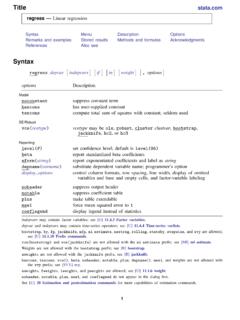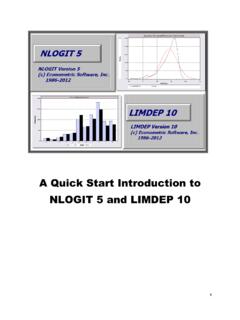Transcription of Python for Finance
1 2n d Ed iti on Python for Finance MASTERING DATA-DRIVEN Finance . Yves Hilpisch SECOND EDITION. Python for Finance Mastering Data-Driven Finance Yves Hilpisch Beijing Boston Farnham Sebastopol Tokyo Python for Finance by Yves Hilpisch Copyright 2019 Yves Hilpisch. All rights reserved. Printed in Canada. Published by O'Reilly Media, Inc., 1005 Gravenstein Highway North, Sebastopol, CA 95472. O'Reilly books may be purchased for educational, business, or sales promotional use. Online editions are also available for most titles ( ). For more information, contact our corporate/institu . tional sales department: 800-998-9938 or Editors: Susan Conant and Jeff Bleiel Indexer: Judith McConville Production Editor: Kristen Brown Interior Designer: David Futato Copyeditor: Rachel Head Cover Designer: Karen Montgomery Proofreader: Kim Cofer Illustrator: Rebecca Demarest December 2014: First Edition December 2018: Second Edition Revision History for the Second Edition 2018-11-29: First Release 2019-01-18: Second Release 2019-05-31: Third Release 2019-12-13: Fourth Release 2020-03-20: Fifth Release 2020-07-31: Sixth Release See for release details.
2 The O'Reilly logo is a registered trademark of O'Reilly Media, Inc. Python for Finance , the cover image, and related trade dress are trademarks of O'Reilly Media, Inc. The views expressed in this work are those of the author, and do not represent the publisher's views. While the publisher and the author have used good faith efforts to ensure that the information and instructions contained in this work are accurate, the publisher and the author disclaim all responsibility for errors or omissions, including without limitation responsibility for damages resulting from the use of or reliance on this work. Use of the information and instructions contained in this work is at your own risk. If any code samples or other technology this work contains or describes is subject to open source licenses or the intellectual property rights of others, it is your responsibility to ensure that your use thereof complies with such licenses and/or rights. 978-1-492-02433-0.
3 [MBP]. Table of Contents Preface.. xiii Part I. Python and Finance 1. Why Python for Finance .. 3. The Python Programming Language 3. A Brief History of Python 5. The Python Ecosystem 6. The Python User Spectrum 7. The Scientific Stack 8. Technology in Finance 9. Technology Spending 10. Technology as Enabler 10. Technology and Talent as Barriers to Entry 11. Ever-Increasing Speeds, Frequencies, and Data Volumes 12. The Rise of Real-Time Analytics 13. Python for Finance 14. Finance and Python Syntax 14. Efficiency and Productivity Through Python 18. From Prototyping to Production 23. Data-Driven and AI-First Finance 24. Data-Driven Finance 24. AI-First Finance 28. Conclusion 31. Further Resources 31. iii 2. Python Infrastructure.. 33. conda as a Package Manager 35. Installing Miniconda 35. Basic Operations with conda 37. conda as a Virtual Environment Manager 41. Using Docker Containers 45. Docker Images and Containers 45. Building an Ubuntu and Python Docker Image 46.
4 Using Cloud Instances 50. RSA Public and Private Keys 51. Jupyter Notebook Configuration File 52. Installation Script for Python and Jupyter Notebook 53. Script to Orchestrate the Droplet Setup 55. Conclusion 56. Further Resources 57. Part II. Mastering the Basics 3. Data Types and Structures.. 61. Basic Data Types 62. Integers 62. Floats 63. Booleans 66. Strings 69. Excursion: Printing and String Replacements 71. Excursion: Regular Expressions 74. Basic Data Structures 75. Tuples 75. Lists 76. Excursion: Control Structures 78. Excursion: Functional Programming 80. Dicts 81. Sets 82. Conclusion 84. Further Resources 84. 4. Numerical Computing with NumPy.. 85. Arrays of Data 86. Arrays with Python Lists 86. The Python array Class 88. Regular NumPy Arrays 90. iv | Table of Contents The Basics 90. Multiple Dimensions 94. Metainformation 97. Reshaping and Resizing 98. Boolean Arrays 101. Speed Comparison 103. Structured NumPy Arrays 105. Vectorization of Code 106.
5 Basic Vectorization 107. Memory Layout 110. Conclusion 112. Further Resources 112. 5. Data analysis with pandas.. 113. The DataFrame Class 114. First Steps with the DataFrame Class 114. Second Steps with the DataFrame Class 119. Basic Analytics 123. Basic Visualization 126. The Series Class 128. GroupBy Operations 130. Complex Selection 132. Concatenation, Joining, and Merging 135. Concatenation 136. Joining 137. Merging 139. Performance Aspects 141. Conclusion 143. Further Reading 143. 6. Object-Oriented Programming.. 145. A Look at Python Objects 149. int 149. list 150. ndarray 151. DataFrame 152. Basics of Python Classes 154. Python Data Model 159. The Vector Class 163. Conclusion 164. Further Resources 164. Table of Contents | v Part III. Financial Data Science 7. Data Visualization.. 167. Static 2D Plotting 168. One-Dimensional Data Sets 169. Two-Dimensional Data Sets 176. Other Plot Styles 183. Static 3D Plotting 191. Interactive 2D Plotting 195.
6 Basic Plots 195. Financial Plots 199. Conclusion 203. Further Resources 204. 8. Financial Time Series.. 205. Financial Data 206. Data Import 206. Summary Statistics 210. Changes over Time 212. Resampling 215. Rolling Statistics 217. An Overview 218. A Technical analysis Example 220. Correlation analysis 222. The Data 222. Logarithmic Returns 224. OLS Regression 226. Correlation 227. High-Frequency Data 228. Conclusion 230. Further Resources 230. 9. Input/Output Operations.. 231. Basic I/O with Python 232. Writing Objects to Disk 232. Reading and Writing Text Files 236. Working with SQL Databases 239. Writing and Reading NumPy Arrays 242. I/O with pandas 244. Working with SQL Databases 245. From SQL to pandas 247. Working with CSV Files 250. vi | Table of Contents Working with Excel Files 251. I/O with PyTables 252. Working with Tables 253. Working with Compressed Tables 260. Working with Arrays 262. Out-of-Memory Computations 264. I/O with TsTables 267.
7 Sample Data 267. Data Storage 269. Data Retrieval 270. Conclusion 272. Further Resources 273. 10. Performance Python .. 275. Loops 276. Python 277. NumPy 278. Numba 279. Cython 280. Algorithms 281. Prime Numbers 282. Fibonacci Numbers 286. The Number Pi 290. Binomial Trees 294. Python 294. NumPy 295. Numba 297. Cython 297. Monte Carlo Simulation 299. Python 300. NumPy 301. Numba 302. Cython 302. Multiprocessing 303. Recursive pandas Algorithm 304. Python 305. Numba 307. Cython 307. Conclusion 308. Further Resources 309. Table of Contents | vii 11. Mathematical Tools.. 311. Approximation 312. Regression 313. Interpolation 324. Convex Optimization 328. Global Optimization 329. Local Optimization 331. Constrained Optimization 332. Integration 334. Numerical Integration 336. Integration by Simulation 337. Symbolic Computation 337. Basics 338. Equations 340. Integration and Differentiation 340. Differentiation 341. Conclusion 343. Further Resources 343.
8 12. Stochastics.. 345. Random Numbers 346. Simulation 352. Random Variables 353. stochastic Processes 356. Variance Reduction 372. Valuation 375. European Options 376. American Options 380. Risk Measures 383. Value-at-Risk 383. Credit Valuation Adjustments 388. Python Script 392. Conclusion 394. Further Resources 395. 13. Statistics.. 397. Normality Tests 398. Benchmark Case 399. Real-World Data 409. Portfolio Optimization 415. The Data 416. The Basic Theory 417. viii | Table of Contents Optimal Portfolios 421. Efficient frontier 424. Capital Market Line 425. Bayesian Statistics 429. Bayes' Formula 429. Bayesian Regression 430. Two Financial Instruments 435. Updating Estimates over Time 439. Machine Learning 444. Unsupervised Learning 444. Supervised Learning 448. Conclusion 462. Further Resources 463. Part IV. Algorithmic Trading 14. The FXCM Trading Platform.. 467. Getting Started 469. Retrieving Data 469. Retrieving Tick Data 470. Retrieving Candles Data 472.
9 Working with the API 474. Retrieving Historical Data 475. Retrieving Streaming Data 477. Placing Orders 478. Account Information 480. Conclusion 480. Further Resources 481. 15. Trading Strategies.. 483. Simple Moving Averages 484. Data Import 485. Trading Strategy 485. Vectorized Backtesting 487. Optimization 489. Random Walk Hypothesis 491. Linear OLS Regression 494. The Data 495. Regression 497. Clustering 499. Frequency Approach 501. Table of Contents | ix Classification 504. Two Binary Features 504. Five Binary Features 506. Five Digitized Features 508. Sequential Train-Test Split 509. Randomized Train-Test Split 511. Deep Neural Networks 512. DNNs with scikit-learn 512. DNNs with TensorFlow 515. Conclusion 519. Further Resources 519. 16. Automated Trading.. 521. Capital Management 522. The Kelly Criterion in a Binomial Setting 522. The Kelly Criterion for Stocks and Indices 527. ML-Based Trading Strategy 532. Vectorized Backtesting 533.
10 Optimal Leverage 538. Risk analysis 539. Persisting the Model Object 543. Online Algorithm 544. Infrastructure and Deployment 546. Logging and Monitoring 547. Conclusion 550. Python Scripts 550. Automated Trading Strategy 550. Strategy Monitoring 553. Further Resources 554. Part V. Derivatives Analytics 17. Valuation Framework.. 557. Fundamental Theorem of Asset Pricing 558. A Simple Example 558. The General Results 559. Risk-Neutral Discounting 560. Modeling and Handling Dates 561. Constant Short Rate 563. Market Environments 565. Conclusion 568. x | Table of Contents Further Resources 569. 18. Simulation of Financial Models.. 571. Random Number Generation 572. Generic Simulation Class 574. Geometric Brownian Motion 577. The Simulation Class 578. A Use Case 580. Jump Diffusion 582. The Simulation Class 583. A Use Case 585. Square-Root Diffusion 587. The Simulation Class 588. A Use Case 590. Conclusion 591. Further Resources 592. 19. Derivatives Valuation.

